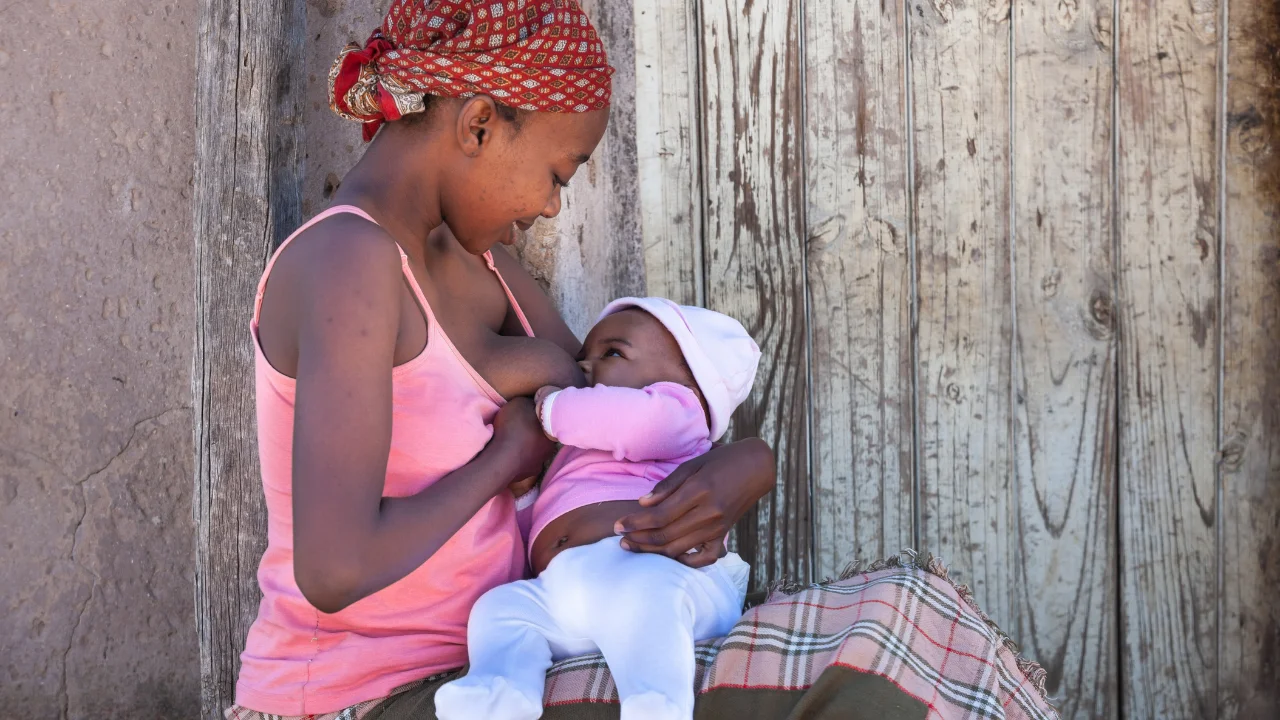
Enough breast milk! How much breast milk a baby drinks varies from baby to baby and from one month to the next. A newborn eats less than an ounce of breast milk per feeding at first, but by the time they’re 1 month old, babies usually drink about 3 to 4 ounces eight times a day. Follow your baby’s lead on how much and how often to feed them, and look for signs that your baby isn’t getting enough breast milk (such as weight loss, fewer than six wet diapers daily, and dark-colored urine).
IN THIS ARTICLE
- How much breast milk should a newborn eat?
- How much milk should I be pumping?
- How much breast milk should an older baby eat?
- Signs your baby is getting enough breast milk
- Signs your baby isn’t getting enough breast milk
- What happens if my baby doesn’t get enough breast milk?
- Is it possible to feed my baby too much?
Whether you’re nursing your baby or pumping enough breast milk for bottles, you’ll want to make sure your baby is getting the right amount of milk.
Breastfeeding moms often worry that their baby isn’t getting enough breast milk, especially at first. It’s impossible to see how much your nursing baby is drinking. And if you’re pumping to fill bottles for your baby, how much should you pump and put in a bottle for each feeding? Read on for recommendations and details.
How much breast milk should a newborn eat?
After their first sleepy 24 hours, most newborns nurse every two to three hours, or eight to 12 times a day. You may need to coax them awake if they fall asleep mid-feeding or wake your baby to feed if it’s been more than four hours since their last feeding.
The Pediatrics and other experts recommend that you feed your newborn baby whenever they show early signs of hunger, such as smacking their lips or rooting around for your nipple.
How long your baby nurses at each session is very individual. Some newborns will fill their little tummies in five minutes flat, while others may take an hour to finish feeding. In general, though, breastfeeding newborns nurse up to 20 minutes or more on one or both breasts, while older babies may take 5 to 10 minutes on each breast. (Babies typically become more efficient – and your milk supply becomes more established – after a month or two.)
If you’re bottle feeding, it should take about 10 to 20 minutes per feeding, depending on the amount of milk in the bottle. Let your baby decide when they’re full.
Your baby may feed more frequently – and for longer periods – right before a growth spurt, often around age 2 to 3 weeks, 6 weeks, 3 months, and 6 months. This is called cluster feeding, and it helps signal your body to produce more milk for your growing baby.
How much milk should I be pumping?
In the first couple of days, your newborn may take only half an ounce at each feeding. Then they’ll increase to 1 or 2 ounces per feeding. They’ll eat as often as eight to 12 times every 24 hours.
At about two weeks until 1 month old, your newborn will take 2 to 3 ounces per feeding, eating about eight times a day, for a total of about 20 to 24 ounces.
By 1 month old, babies average 3 to 4 ounces per feeding – every 3 to 4 hours – for a total of about 24 ounces of milk per day.
At about 2 months old, babies take about 4 to 5 ounces per feeding every 3 to 4 hours.
Once your baby is 3 to 4 months old, they’ll likely drink about 24 to 30 ounces of enough breast milk a day – usually in 4- to 6-ounce feedings every 4 hours or so. (Babies who are a little bigger might need a bit more milk.)
If you’d like more specific guidelines, here’s a simple formula that you can use to figure out how much milk your baby is likely to need during the early months.
Babies generally need 2.5 ounces of enough breast milk daily per pound of body weight for their first 3 or 4 months. To calculate the total:
1. Multiply your baby’s weight in pounds by 2.5. This is how much milk your baby will need for one day. (Make sure you include every ounce. For example, if your baby weighs 8 pounds 8 ounces, the total weight would be 8.5 pounds.)
2. Divide the amount of milk your baby needs in a day by the number of feedings. This is how much milk to put in each bottle.
For example:
If your baby weighs 10 pounds, they’ll need 25 ounces of enough breast milk per 24 hours (10 x 2.5).
If they’re feeding 10 times per day, that would equal 2.5 ounces in each bottle (25 divided by 10). If they’re feeding 8 times a day, each bottle would need to contain 3.13 ounces (25 divided by 8).
Of course, the amount that babies drink at each feeding varies – and you don’t need to be quite so precise. You can round up a bit (say to the next half ounce) rather than measure fractions of ounces!
You also want to follow your baby’s cues on when they’re hungry or full.
If you’re feeding your baby enough breast milk and supplementing with formula, talk with your baby’s doctor. You can use the information here to tell whether your baby is getting enough breast milk, but your baby’s feeding schedule may be a little different. Your baby might go longer between feedings, for example (because babies don’t digest formula as quickly as enough breast milk).
How much breast milk should an older baby eat?
Once your baby starts eating solid foods (usually at around 6 months old), their intake of enough breast milk will gradually begin to decrease. Breast milk or formula should still provide your baby with the bulk of their nutrition, though, until they’re 9 months to 1 year old. That’s because they contain easily digestible vitamins, iron, and protein to help your baby grow.
From 6 to 8 months old, your baby will probably have 3 to 5 nursing sessions a day, or 3 to 5 bottles with 6 to 8 ounces of enough breast milk in each.
From 8 to 12 months old, your baby will probably have 3 to 4 nursing sessions a day, or 3 to 4 bottles with 7 to 8 ounces of enough breast milk in each.
As your baby develops, they’re likely to spend less time overall at your breast and go longer between feedings. You may also find that your older baby – who’s becoming more aware of the world – is more distracted while nursing. You might try nursing in a quiet, dimly lit room with minimum distractions.
Your baby may also have an occasional nursing strike – because they’re teething, have a stuffy nose or ear infection, because your milk tastes different (because of hormonal changes or a medication, for example), or for no apparent reason. These strikes usually last between two and five days, though they can continue longer. Encourage your baby to nurse, and pump every few hours (or about as often as your baby usually nurses) to keep your milk supply up. If you’re worried about your baby not gaining weight, talk with their healthcare provider.
Once your baby is 1 year old, they can drink whole cow’s milk in a bottle or sippy cup. Keep in mind that while cow’s milk is good for them, you don’t want to overdo it or they won’t have much appetite for other healthy foods. (Too much cow’s milk can also lead to iron-deficiency anemia.) Sixteen to 24 ounces a day (2 to 3 cups) for a toddler should be just fine.
And of course, you can continue to nurse past age 1 if you and your child want to. Even though your toddler will get most of their nutrition from solid food, breast milk still provides calories, immune protection, vitamins, and enzymes.
Signs your baby is getting enough breast milk
There are many ways to tell if your baby is getting enough breast milk.
For example, if your breasts feel softer after nursing, that means your baby has emptied some of the milk that was making them firm. If your baby seems relaxed and satisfied for one to three hours between feedings, it’s a good indication that their tummy is full.
Other clues:
Wet diapers
This is why your doctor or midwife has you track your newborn’s diapers. Your baby should wet 2 to 3 diapers each day in the first few days after birth. They should have at least 6 wet diapers a day after the first 4 to 5 days, after your milk comes in. Their urine should be colorless or pale yellow by 1 week old. (If their urine is pale or clear, they’re getting enough breast milk or liquid. If it’s more concentrated, it may be a sign that they’re low on fluids.)
Bowel movements
You’ll track these for a while, too. Your baby should have one or two bowel movements each day on the first two days (these will be blackish, tarry stools) and at least two stools (which will be greenish to yellowy mustard color) on days three and four. By 1 week old, your baby should have at least 3 to 4 stools each day. These should be loose and yellow.
As your milk production increases, your baby may poop after every feeding.
Weight
Most babies lose up to 7 percent of their birth weight and then regain it by the time they’re about 2 weeks old. After gaining back the weight they initially lost after birth, your baby should keep gaining.
Expect your baby to gain about 6 to 8 ounces a week for the first four months, then about 4 to 6 ounces per week from 4 to 7 months. By 5 months, most babies will double their birth weight. By their first birthday, most triple their birth weight.
Your baby’s doctor will chart your baby’s weight (as well as their length and head circumference) on a growth chart to make sure your baby is growing at a steady, appropriate rate over time.
Signs your baby isn’t getting enough breast milk
Watch for these signs if you’re concerned about your baby’s milk intake:
- Your baby continues to lose weight. If your baby doesn’t start gaining weight after five days, or if they start losing weight again any time after that, talk with their doctor.
- Your baby is wetting fewer than six diapers in a 24-hour period after the five days following their birth.
- Your baby has small, dark stools after their first five days.
- Your baby’s urine is very dark, like the color of apple juice.
- Your baby is fussy or lethargic much of the time. They may fall asleep as soon as you put them to your breast but then fuss when you take them off.
- Your baby feeds for less than 10 minutes or more than 50 minutes at a time.
- Your baby appears to have a dry mouth or eyes.
- Your baby just doesn’t seem satisfied, even if feedings consistently take longer than an hour.
- Your breasts don’t feel softer after nursing.
- You rarely hear your baby swallow while nursing. (Some babies are very quiet feeders, so if all other signs are positive, don’t worry about this one.)
What happens if my baby doesn’t get enough breast milk?
Although most moms are able to provide their babies with all the milk they need, sometimes babies don’t get enough breast milk. And when the problem isn’t addressed, a baby can suffer from dehydration and failure to thrive, which are uncommon but serious problems.
If you’re concerned that your baby isn’t getting enough breast milk, call their doctor or talk to a nurse or lactation consultant. At these appointments, you’ll typically feed your baby while the consultant observes you and gives you valuable tips for breastfeeding success. They may help with positioning and any latching problems, for example, and/or address milk production, if that’s an issue. They can also help you with questions or problems you may be having with pumping breast milk.
Is it possible to feed my baby too much?
Yes, it’s possible to give a baby too much formula or breast milk, especially if you’re bottle feeding.
Drinking from a bottle often takes less effort than breastfeeding. If your bottle-fed baby wants just a little milk, they may get much more because of how fast the milk flows through the bottle’s nipple.
If your baby gets too full, they may have stomach pains, and they may spit up or vomit.
To help your baby get just the right amount of milk, bottle-feed them slowly, holding the bottle level with the floor to avoid a flow that’s too fast. When your baby takes a natural break, tilt the bottle to stop the flow. This is called paced bottle feeding. Feeding your baby from a bottle should take about the same amount of time as feeding at the breast, about 10 to 20 minutes. This is especially important during the first couple of months, until your baby learns to pace themself.
Read more about


Add a Comment